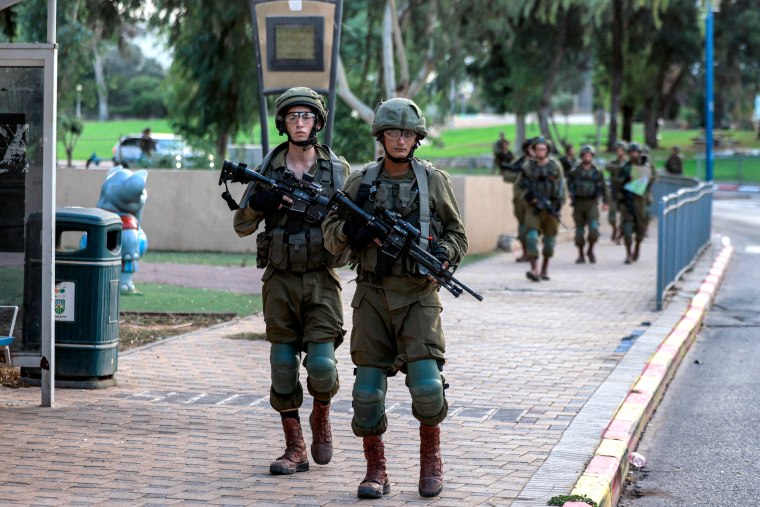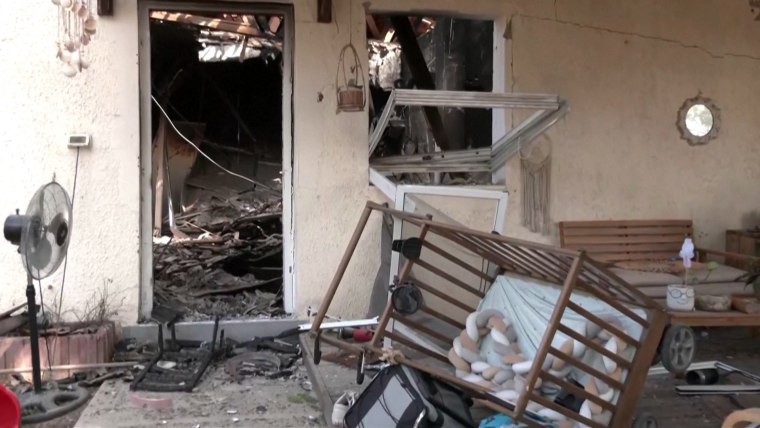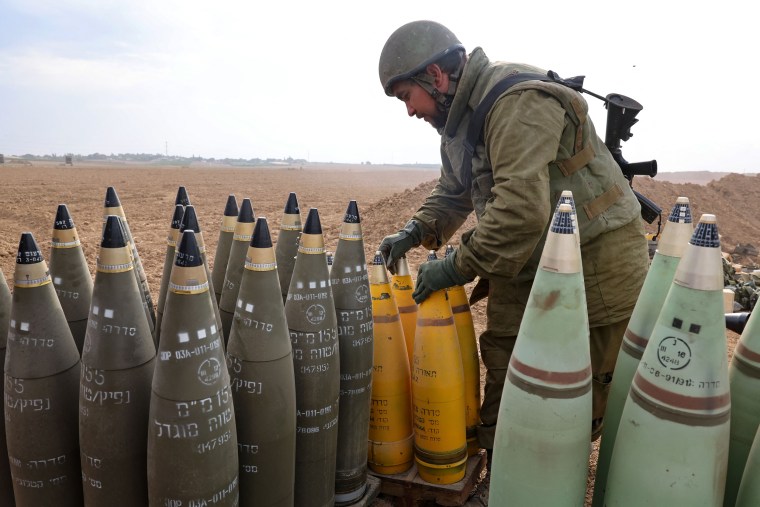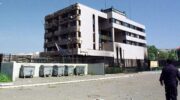Warning: This article includes graphic images.
KFAR AZA, Israel — The bodies of Hamas fighters lay on the streets of this kibbutz close to the border with Gaza on Tuesday as Israeli soldiers went door to door to secure it days after it was overrun.
The bodies were among the 1,500 dead militants Israel says it found inside its border after Hamas’ surprise raid from Gaza.
Among the grim, extraordinary numbers that tell the story of the militants’ attack on Israel, that one, in particular, has dumbfounded experts. It raises the question of how large Hamas’ total fighting force is — and what a bloody, close-quarters ground offensive on the Gaza Strip might look like if Israel launches one in the coming days.
“I don’t think there’s a way to overstate how extraordinarily difficult it will be,” said Tobias Borck, a Middle East expert at the Royal United Services Institute, a London think tank. “It’s not going to just be street by street but house by house and tunnel by tunnel.”
Follow our live coverage here.
 Israeli soldiers have been patrolling southern towns to restore control in the wake of the Hamas attack.Menahem Kahan / AFP via Getty Images
Israeli soldiers have been patrolling southern towns to restore control in the wake of the Hamas attack.Menahem Kahan / AFP via Getty ImagesMost analysts agree that some form of ground offensive is inevitable.
Israeli Prime Minister Benjamin Netanyahu, whose right-wing government is under pressure to react quickly and decisively after having been surprised by Saturday’s attack, made it clear that this one was unlike other conflicts with Palestinian militants: Israel would fight this war with a “mighty vengeance,” he said, as he and other Israeli officials vowed to destroy Hamas’ military capabilities.
That would be difficult, if not impossible, using airstrikes alone, which are already battering the tiny, blockaded Gaza Strip. And seemingly to that end, Israel has called up 360,000 reservists, adding to its standing army of 170,000.
“I can tell you that we’re weighing the situation very carefully,” an Israel Defense Forces spokesman, Maj. Doron Spielman, said Monday when he was asked whether the military was preparing a ground offensive. “This is an entirely new paradigm to the way we have weighed other conflicts in the last few years.”

'It's not a battlefield; it's a massacre': Israeli military officer describes aftermath of Hamas assault on a kibbutz
He told NBC News on Tuesday he did not have any additional information about a potential ground offensive or Israel’s assessment of Hamas’ strength.
In 2021, The Times of Israel quoted an unnamed senior Israeli commander as saying Hamas had an army of 30,000 men, replenished since its 2014 war with Israel. NBC News is not able to confirm those numbers, and Hamas does not disclose that information.
One problem with those estimates is that it is not exactly clear what constitutes a Hamas fighter.
“Is that counting people who have held a gun, or only those who have received a degree of training?” Borck said. “Israel’s objective now is to destroy Hamas’ military capability. The problem with that statement is we don’t know what Hamas’ military capability is.”
 An Israeli soldier arranges artillery shells Monday on the border with Gaza in southern Israel. Jack Guez / AFP via Getty Images
An Israeli soldier arranges artillery shells Monday on the border with Gaza in southern Israel. Jack Guez / AFP via Getty ImagesTo carry out Saturday’s attack, the militant group used some of its most elite forces, namely the Nakba unit, which has 3,000 to 5,000 fighters, said Michael A. Horowitz, a geopolitical and security analyst who is the head of intelligence at the Le Beck consultancy.
“So this means between half to around a third of some of Hamas’ elite commando force has been killed,” he said.
The 1,500 reported killed could also include fighters from a smaller Palestinian militant group, Islamic Jihad, according to Yezid Sayigh, a senior fellow at the Carnegie Middle East Center in Beirut.
Any ground invasion might resemble the last large-scale Israeli offensive into Gaza in 2014, which lasted 50 days. It came at a cost both for the Israeli army, which lost 66 soldiers, and the Palestinians, with 1,400 of the 2,300 killed thought to be civilians, according to UNRWA, the United Nations’ relief agency for Palestinian refugees.
 Israeli soldiers stand near the body of a Palestinian militant in Kfar Aza on Tuesday. Thomas Coex / AFP – Getty Images
Israeli soldiers stand near the body of a Palestinian militant in Kfar Aza on Tuesday. Thomas Coex / AFP – Getty ImagesWith more than 2 million people crammed inside an area twice the size of Washington, D.C., Gaza remains one of the most densely populated and impoverished places in the world. Israel and Egypt have blockaded it for 16 years, strictly controlling the movement of goods and people, strictly controlled, which Israel says is necessary to thwart the militants residing there.
But unlike nine years ago, Gaza is now also where dozens of hostages militants captured over the weekend are being held.
In a conflict that strikes deep emotional chords in the region and around the world, the uncertain fate of those captives has added yet another layer of turmoil that only intensified after Hamas threatened to execute them if Israel bombed civilians in Gaza.
 Israeli soldiers have been gathering near the Gaza border.Ilia Yefimovich / dpa/picture alliance via Getty Images
Israeli soldiers have been gathering near the Gaza border.Ilia Yefimovich / dpa/picture alliance via Getty ImagesThe hostages “have likely already been dispersed throughout the Gaza Strip,” which “is riven with tunnels, bunkers, and other concealed places that will make locating, much less rescuing, the hostages difficult,” Bruce Hoffman, a senior fellow at the Council on Foreign Relations, wrote in a briefing.
“These places and perhaps even the hostages themselves will likely be laden with traps,” he said. “This is a challenge of a magnitude that has never been faced before.”
Israel’s army is well-known for being high-tech, and its Merkava tanks could take up positions in the fields near the Gaza-Israel border. But they would become extremely vulnerable to ambush once they are inside the enclave’s densely packed streets, analysts agree.
Even then, defeating Hamas may not be the end of the conflict.
Hoffman said a full-scale ground offensive could spark the involvement of the Lebanese militant group Hezbollah — or even Iran, which backs both Hezbollah and Hamas.
And some experts fear any ground offensive might lead to a longer-term Israeli military presence inside Gaza for the first time since 2005, when it withdrew 38 years after having captured it.
“Whatever the tactics, I see no way for Israel to gain effective military control without a dense presence on the ground that will have to last months at least, which will generate its own multiple problems,” said Sayigh of the Carnegie Center.
“Obviously, Palestinian civilian casualties will be horrendous.”
Richard Engel and Marc Smith reported from Kfar Aza and Alexander Smith from London.




